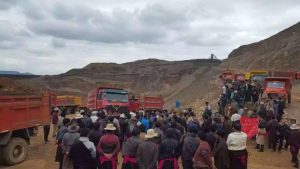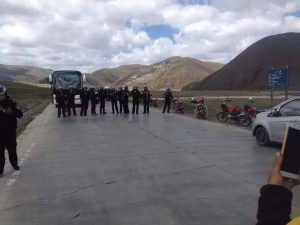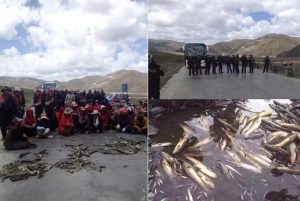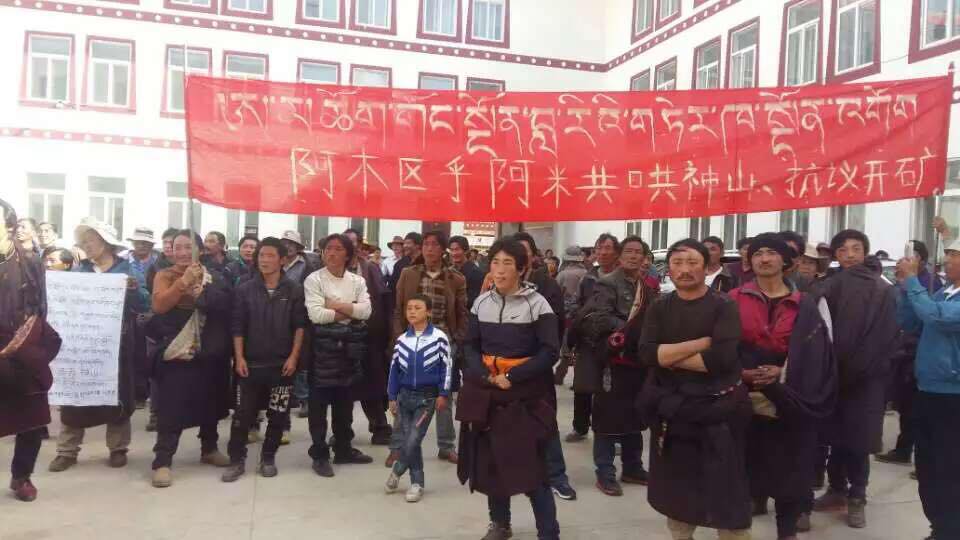Meanwhile, Tibetan communities, who have lived under the brutal Chinese regime for decades, have been left powerless to defend their land. Many living close to the mining sites will lose their livelihoods as mining operations cause soil erosion and destroy local agriculture while in other cases the damage will be so severe it will mean entire villages will need to be relocated.
Even more concerning is the massive potential health risk caused by the mining of metals such as gold and copper. These highly desirable metals are usually found in rock formations that are loaded with arsenic. When the metals are extracted the chemical is released, potentially contaminating water sources. The same water sources that feed into some of Asia’s largest rivers that around 1.3 billion people depend on including the Ganges, Yangtse, and Salween.
Any villager that raises concerns over this to the local authorities will likely be arbitrarily detained, tortured or even executed. However despite these dangers, there is growing resistance amongst the Tibetan population.
One such site is Gong-ngon Lari Mountain, where decades of open-pit gold mining is having disastrous consequences on the natural environment and has deeply offended the local community who consider the mountain to be home to their protector deity.

The community in the Amchok Township believe the mining project is in breach of Chinese law, which requires the consent of the local people, and for years they have voiced objections to the authorities. These protests have become so desperate that in 2012 two young Tibetans set themselves on fire at the mine’s entrance.
Years of frustration within the community boiled over again at the end of May when over 300 locals marched through the streets carrying a huge red banner emblazoned with the slogan: “Stop Mining at Amchok Gong Ngon Lari!” The crowd boldly gathered to confront armed police forces and demanded an end to the mining.
Within days the Chinese authorities set into motion their usual brutal response. A large number of armed police and paramilitary personnel were deployed and they swiftly attacked the protesters resulting in six being badly injured and detained and two others beaten so severely they were rushed to hospital for emergency treatment.
The township government then issued a warning in a letter to residents condoning the brutality. It said protestors would have to “take full responsibility” for the consequences of their demonstration. They also blamed “evil and corrupt people” for instigating the demonstration, implying the protests were linked to the exiled Tibetan government based in Dharamshala, India.
The following morning around 2,000 residents signed a petition to call for an end to the gold mining. They were also forced to choose between continuing their protest or negotiating the release of the detained protesters, so the demonstrations came to an end and the six wounded protesters were released. However, the two who were rushed to hospital remain missing.
Mining operations at the sacred mountain are now resuming and based on images and videos released online, there has been a massive deployment of Chinese security forces to prevent any further dissent.

This series of events may seem to be a lost cause but the routine brutality used against Tibetans who want to protect their land is beginning to become counter-productive. The protesters are sure to return but in larger numbers and they will gradually adapt to the security forces’ methods.
In addition to this, Beijing is fast losing its ability to prevent information being broadcast to the world. In the past one of their strongest weapons in Tibet has been silence due to extreme restrictions on freedom of speech and a ban on foreign journalists. But in the case of Gong-ngon Lari, smartphones were able to capture images and videos and reports of the violent response from security forces did not go unnoticed.
Reports and images spread across the Internet and social media and soon caught the attention of a group who aim to continue the protest through very modern day means and through a form of resistance that cannot be stopped through brute force.
The group is an international team of activist hackers affiliated with Anonymous, and they have declared they will show solidarity with the people of Tibet and continue their protest. On June 11 the first corporate mining site was hijacked and completely defaced with images of the Guy Fawkes mask that has become the trademark of Anonymous hackers.
There is no official confirmation if the company they attacked is directly responsible for the mining in Amchok, but according to the group, it will not be the last.
In a follow-up video statement posted on YouTube the hacktivists, using the title #Op_Tibet, said they have identified and confirmed a number of websites that are run by Chinese mining corporations and these companies will also be targeted in their campaign.
“Each and every day these sites are offline and or defaced is causing disruption, financial delay and loss to those greed obsessed companies who are inflicting serious damage upon the Tibetan people and their lands,” reads the man in the video, hidden behind a mask.
The group does not appear to have attacked any other web servers yet but in a social media post they have released the web addresses of over 50 intended targets.
Despite being hidden to many due to the nature of what they do, word of Anonymous’ support for the Tibetan cause is likely to bolster the spirits of communities who have resisted the exploitation of their land alone for many years. And as China accelerates its large-scale mining for copper, gold, silver, lithium and chromium in Tibet the protests are also likely to get stronger and potentially more violent.
In the last month alone, two protests on a similar scale to the one at Gong-ngon Lari Mountain were reported. In Akhori Township in Chuchen County demonstrations against the construction of a road for mining minerals at a holy mountain led to 20 Tibetans being beaten and seven detained. And in Yulshok Gargye in Minyak County more than 100 Tibetans protested against ongoing mining that has led to toxic waste being dumped into a local river, poisoning drinking water and killing large numbers of fish.

These demonstrations are extremely dangerous for Tibetans as they risk brutal crackdowns but they are also a clear indication that China’s oppressive policies in Tibet remain ineffective and counterproductive.
The only way Beijing can bring the continued unrest to an end is by working with the Tibetan community and negotiating some form of genuine autonomy. Until then the region, which the Beijing-based Foreign Correspondents Club of China calls, “the most intriguing and tightly controlled region in China today,” will continue to be plagued with unrest relating to economic, business and human rights issues.

